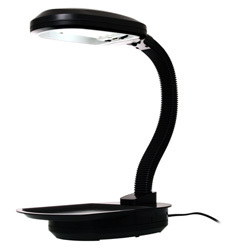Does My Bonsai Tree Need A Grow Light?
14th Mar 2016

It's no secret that there are a lot of accessories and tools a true Bonsai enthusiast may collect in the pursuit of their beloved hobby... but this can also be offputting to newcomers who want to try their hands at growing a Bonsai with minimal investment beyond the cost of the tree.
A grow light is one of those accessories that might or might not be needed, depending on your local environment as well as the needs of the specific tree species. So today, we wanted to take a look at grow lights, when they're useful, and how to guarantee best results when you do use one.
When Are Grow Lights Needed?
The most common usage for grow lights is for indoor growing or training species of Bonsai that are normally outdoor trees. Outdoor Bonsai expect near-constant sunlight during daytime hours, and will do poorly -or start to sicken- if they don't receive enough light.
It's obviously best to keep them outside, but they may not be able to handle harsh winters. Certain training methods, especially more extreme styles, may also be best conducted indoors to prevent weather fluctuations -like high winds- from affecting their development. In these cases, a proper grow lamp may be a near-necessity unless there's a place in your house that receives a lot of direct light throughout the day.
For newcomers, the obvious solution here is simply to buy a breed of Bonsai that's comfortable indoors with lower light levels, such as the Ginsing Ficus or the Fukien Tea.
Which Grow Bulbs Should Be Used?
When using a grow light on Bonsai, the best bulbs to use are "full-spectrum" fluorescents, which output the natural UV range that sunlight contains.
A lot of grow lights for other species may be based on incandescent bulbs, but these can quickly damage a Bonsai when used improperly. Incandescent bulbs generate a lot of excess heat and, when placed near to a Bonsai, will harm or even scorch its leaves, branches, and trunk. Just like people and animals, overheating a Bonsai can quickly sicken or kill it.
If an incandescent is used, the bulb should be well away from the tree and, preferably, in an area with good airflow and/or air-conditioning to ensure minimal heat buildup. So, while fluorescent bulbs are a bit more expensive, they're a much better choice overall.
How To Match The Change In Seasons?
In particularly picky outdoor Bonsai, which may be better-suited for an outdoors greenhouse anyway, it might be necessary to try to mimic the passing of seasons for best effect.
One can attempt to do this manually, simply by running the light for longer during summer months and shorter periods during the winter. (Or vice-versa if you're in the southern hemisphere.) Most Bonsai will do fine with this approach, as long as you're consistent with it.
The other option is buying a smart grow lamp. These use a combination of computer-control and in-soil sensors to track the time of day, period of the year, and how much heat is building up in the soil. These can create a full hands-off nursery for finicky outdoor Bonsai, automatically adjusting the light levels to meet their needs throughout the day.
Know Your Bonsai Tree's Needs!
As always, the best approach here is to consult a care guide for your Bonsai and find out how much light it needs to thrive. A grow light isn't needed with more tolerant indoor breeds, but could be a requirement if you're trying to train outdoor Bonsai in cold climates.
Need more help? Just contact the experts at BonsaiOutlet for advice!
